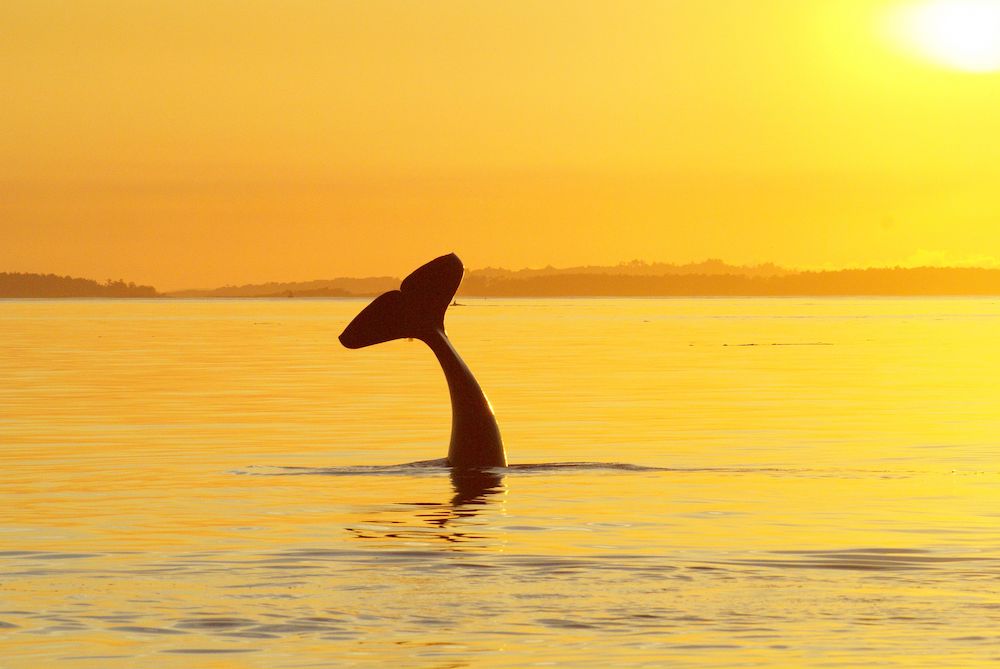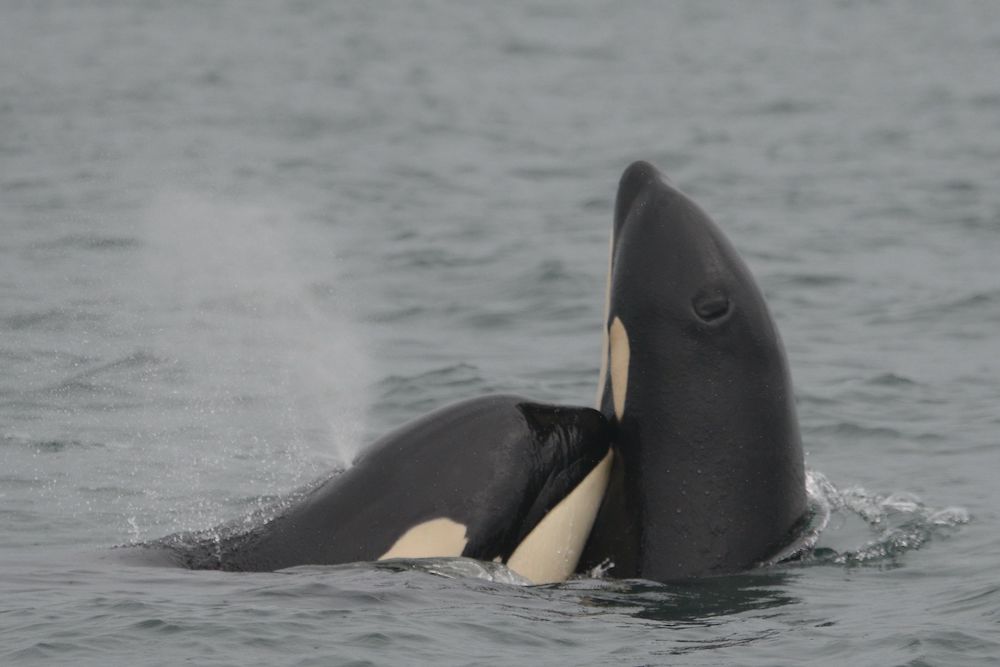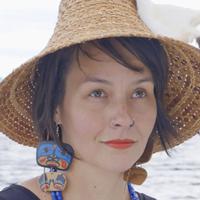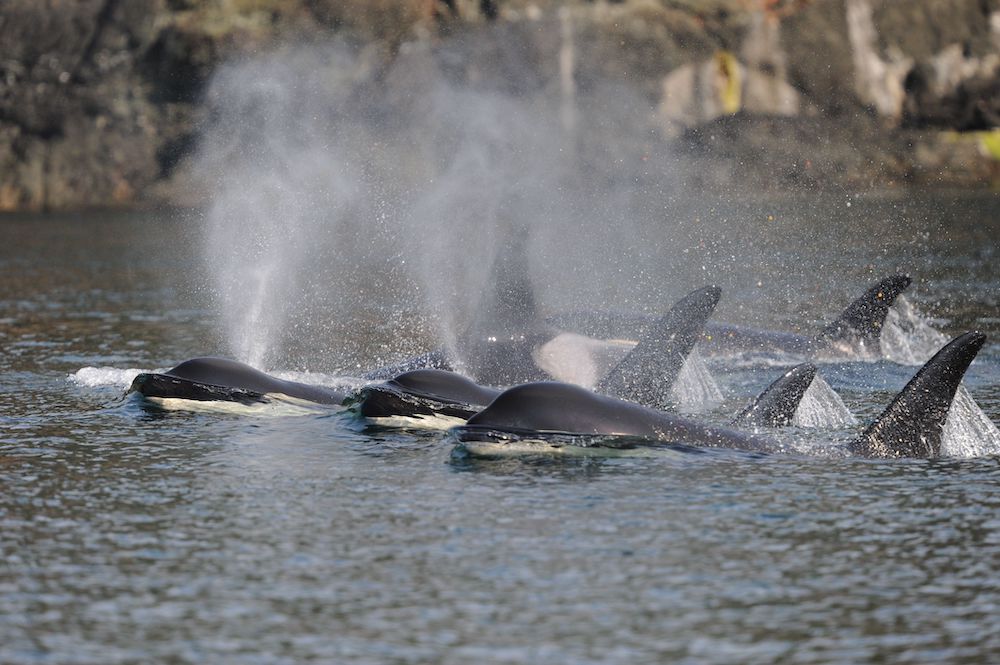[Editor’s note: The following essay is excerpted from the new compilation 'Spirits of the Coast: Orcas in Science, Art and History,' published by the Royal British Columbia Museum. Learn more or purchase a copy here.]
i. Slow rolls in the fog
Once when I was a little girl, I was in a skiff with my father. (This sentence is how all my best childhood stories begin.) This particular time, we were travelling from the village out to camp. It was spring, and the fog was so thick that we were travelling by instinct and memory. The vessel reminded me of a piece of driftwood: curved, light and somehow a little impermanent. I always sat perched high when we travelled in that boat, nestled on top of our gear, my hip to the gunwale so I could lean over and stare into the ocean.
As we puttered slowly down the channel, a pod of orcas appeared. It was as though they’d manifested out of the dense fog, and although they overtook us quickly, their pace seemed to slow to match their curiosity. They surfaced and dove too quickly to count them all; it was orcas all the way down. They performed lazy rolls, the calves clumsy as they practised their spyhopping. Occasionally an adult would breach — with the elegance of a salmon, and the enormous power of rolling thunder.
Their clicks and cries made the skiff shake, and their vocalizations vibrated up into my bones. The hull of the boat was the most fragile of liminal spaces dividing me from the whales, and the closeness made me feel a sense of deep safety — like the ocean was a womb and they were the pulse of my mother, beating all around me.
They paced us for awhile, the females and their calves closest to the boat and the rest of the pod radiating outward. The dorsal fins that cut the surface were dark against the backdrop of the ocean, and darker against the fog. And there we were, my father and I, cupped in the curve of our little skiff with the barrier between ocean and sky dissolving all around us.
Gradually, the pod carried on ahead of us. And the last we saw was a magnificent bull whose massive head plowed straight toward our boat, turning into a slow dive so close to us that the top of his dorsal fin was within arm’s reach just before he disappeared beneath the hull.
I thought I would feel bereft in that moment; instead I felt full. And to this day, nearly three decades later, that moment is what slips into my mind when I think of the definition of prayer.
ii. Kingdom under the sea
In the Haíłzaqv (Heiltsuk) way of knowing the world, there is a kingdom under the surface of the ocean that is as complex and organized as our society above the surface. The chief of this kingdom is a figure called Qvúmúgva. He is at the centre of a system of knowledge, laws, stories and governance that provides structure to the relationships between the species that form a community in the ocean; his authority also shapes how we relate to the constituents of the kingdom under the sea.
To accept Qvúmúgva’s authority is to reject the colonial concept of human supremacy over the natural world, particularly the ocean. Through the respect he commands, he reminds us that when we are in and on the ocean, the locus of power rests within his hierarchy — not ours. The oral history gifted to us down the generations from our ancestors teaches that the hḷ́x̌ʔínúx̌v, the orca, accompanies Qvúmúgva’s house as he moves throughout his kingdom. The hḷ́x̌ʔínúx̌v is a signifier of Qvúmúgva’s presence and authority, a herald that can move between worlds and communicate both above and below the ocean’s surface.
In our relationship to the ocean, Qvúmúgva humbles us. He reminds us that a power greater than us is at play. And the hḷ́x̌ʔínúx̌v that travels with him, making his presence and power known, is a visual reminder of that call to be humble. Are you capable of feeling small without feeling threatened? How does your ego concede to proofs of nature’s supremacy? When an apex predator and awe-striking being like a hḷ́x̌ʔínúx̌v spyhops or rolls slowly beside your boat, what do you feel when you meet its eye?
If we can put our instinctive anthropocentrism aside and accept what Qvúmúgva and his attendants represent — a system of undersea laws and governance in a marine society that operates independently of us — we can begin to understand that the ocean is not some mare nullius where we can exercise our sense of human entitlement. How does our behaviour change when the ocean is a sovereign space? When there is an authority figure, like Qvúmúgva, who sets a bar of accountability and respectful relations? When the beings who are citizens of that Nation are our kin?
Moving between worlds, the hḷ́x̌ʔínúx̌v is a reminder from Qvúmúgva to humble ourselves — a messenger who carries teachings of humility. If we have the capacity for humility, we have the capacity for respect and empathy. If we can embody that triad of teachings, maybe we can become the kind of relations that the hḷ́x̌ʔínúx̌v and other denizens of Qvúmúgva’s kingdom deserve.

iii. Motherhood and grief
Like many others, I watched with an ache in my heart in 2018 when Tahlequah, an orca in the Southern Resident J pod, nudged her dead calf to the ocean’s surface for 17 days in what appeared to be a ritual of mourning.
Orcas and certain other cetaceans have been observed in this sort of vigil for their dead before, but the length of time and the physical distance that this mother carried her dead calf is new to our human frame of reference. It was widely reported as a “sad spectacle” — a phrase that implies a passivity in us, mere spectators. But I believe that grief was meant to be active — to be participatory.
Grief is ceremony. It can have elements that are both private and public, but when it is enacted in a public way as Tahlequah’s was, we can’t be simple spectators. We need to be witnesses.
In Haíłzaqv culture, to be a witness is a deep responsibility. It obligates you to be an archive embodied, ready to recall the events and the ceremonies you have witnessed and the business that has been conducted before you when the record of your testimony is required. In the context of a potlatch or a feast, the hospitality shown to you by the host and the gifts that you receive are how you are paid in advance for the testimony you may some day be called upon to provide. Memory is part of reciprocity.
In the context of Tahlequah’s mourning, bearing witness is how we must reciprocate the ocean’s generosity, the feasts it has provided us, the gifts it has given us.
Like orca pods, Haíłzaqv society is gathered around matriarchs. We trace our ties through our mothers, our lifegivers. And inextricably linked to the ritual of birth is the ritual of death. While our matriarchs bring future generations into being through the ceremony of birth, they also perform many of the ceremonies that guide us through death and loss; these ceremonies honour the departed, but they also teach us, those who are still alive, a new way of being in the wake of death.
I don’t know why Tahlequah’s calf died. I can recite the pressures that bear down on the ocean, on orcas in general, on Tahlequah’s pod in particular. I carry that anxiety in my bones like ocean salt etching into my marrow. Dwindling food sources. Chemical and noise pollution. The lingering intergenerational impacts of all the live captures in decades past. The hazards of shipping oil. The low howl of climate change.
My empathy overwhelms me at times because what I see in our ocean relatives so closely parallels what I see in my own community; we’ve also felt starvation and contamination. We’ve also heard our languages drowned out by white noise and felt the intergenerational trauma of fractured families. We’ve also calculated what we stand to lose to an oil spill and stared down the uncertain future of a wildly shifting climate.
As a Haíłzaqv mother, I am conscious every day that I owe my existence to the resilience of my ancestors through every generation from the time of creation to the day of my birth. My existence is a testament to their survival. And I feel a fierce urge to be part of the swell of resurgence for our people, to bring my Haíłzaqv babies into the world, to be a good future ancestor. I want to be one little abalone button in the metaphorical ceremonial blanket that represents my matrilineal line back to our creation story. I want that blanket to be heavy with the weight and the richness of many generations to come after me.
I’m sure Tahlequah also feels that same imperative to survive, that generative force deep within her, that need to manifest a future where her genetic memory and intergenerational wisdom can carry on. I cannot imagine the deep grief of losing your offspring. If that mourning was an ocean, I’m not sure I could even imagine standing at its shore. But when I watched the footage of her nosing her dead calf to the ocean’s surface, I felt her pain — in my head, my heart, and my womb.
And when I watched her pod take turns lifting that calf up so she could rest as she completed her sacred work, Tahlequah reminded me that we do not move through grief and uncertainty alone. We do it with our community bearing witness. And our community endures.
That Tahlequah lingered so long over her ritual of mourning should prompt us to ask ourselves whether we received her teachings and internalized what it was we witnessed. Did we respond with the care, attention, and memory that her persistent grief called for? After all, we may be called upon someday to affirm the record on the ceremonies that Tahlequah performed. We are her oral historians. We are her chroniclers. What story did you write on your heart when you watched her?

iv. Building community
I have immense privilege in my proximity to the ocean, to orcas and other beings, to the teachings they offer. And the framework of Haíłzaqv laws, principles and values that informs my worldview helps me to locate myself within cycles and systems; from birth, I’ve been surrounded by people who model the difference between spectators and witnesses — the responsibilities of kinship. But if we want to create the conditions for orcas and all ocean relatives to survive and to thrive, all of us — no matter whether our experience is direct or indirect — need to forge a connection.
The way western society interacts with the world is often rooted in disconnection, in dissociation. We think we are architects of the order of the world, that our needs are the higher needs. This kind of thinking is so firmly embedded in my broader social context, and when it creeps into my thinking, I have to remind myself: think like an ancestor. If disconnection is the root cause of what has made our world, and the orcas’ world, so precarious — the antidote is connection. Building connection is building community.
As I layer all these stories together — my own encounters with orcas, my Haíłzaqv ancestral teachings, the mourning rituals of Tahlequah — what resonates in my body, like whale song rising up through the hull of my father’s skiff, is the belief that community building is the most important work before us. When we practise reciprocity, we spend our lives in service of our community, and we trust that our community’s acts of service will lift us up as well. We become accountable to one another — interdependent.
We need to be part of the pod. We need to be the companions who shoulder Tahlequah’s burden for awhile so she can rest in her grief and regain her strength. We need to be the collective that nourishes and protects all its constituent parts according to their needs. The planet needs us to be connected. The ocean needs us to be connected. The orcas need us to be connected. And through that sense of deep connection, we can build the trust that will help us bring the fullest of our capacity, creativity, and compassion to addressing the complex and systemic challenges our world faces today.
The Haíłzaqv are an oceangoing people. My sense of connection to our waterways and our ocean kin is strong. Maybe you live in the mountains or the prairies. Maybe you live in the dense, urban environment of a major city. Maybe you’re unsure of how to forge the kind of connection that will build community between you and a pod of orcas. But it’s not an impossible task.
When I think about that spring morning in my childhood, and the black fins cutting through ocean and fog, I think about prayer. I feel humbleness, gratitude and a sense of safety. I feel community. I feel home. What makes you feel those things?
Sometimes building community is about exercising vulnerability and allowing yourself to be cared for. Sometimes it’s about power and wielding it in a way that it shelters your kin. As you reflect on your own life, ask yourself where your strongest sense of connection is rooted. Find the analogue in your life that parallels what the hḷ́x̌ʔínúx̌v, what the orca, is to me. Wear that sense of connection boldly, like a gleaming white saddle patch. Find your pod. And in the sense of purpose and resilience that community responsibility generates, know that you have power. ![]()
Read more: Indigenous, Environment
















Tyee Commenting Guidelines
Comments that violate guidelines risk being deleted, and violations may result in a temporary or permanent user ban. Maintain the spirit of good conversation to stay in the discussion.
*Please note The Tyee is not a forum for spreading misinformation about COVID-19, denying its existence or minimizing its risk to public health.
Do:
Do not: